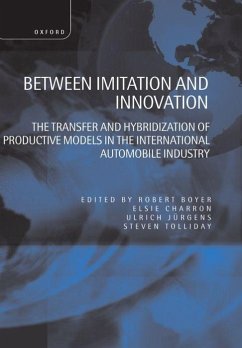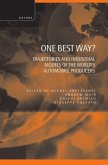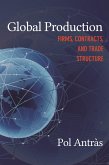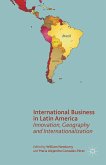Robert Boyer / Elsie Charron / Ulrich Jurgens / Steven Tolliday (eds.)The Transfer and Hybridization of Productive Models in the International Automobile Industry
Between Imitation and Innovation
The Transfer and Hybridization of Productive Models in the International Automobile Industry
Herausgeber: Boyer, Robert; Tolliday, Steven; Jürgens, Ulrich; Charron, Elsie
Robert Boyer / Elsie Charron / Ulrich Jurgens / Steven Tolliday (eds.)The Transfer and Hybridization of Productive Models in the International Automobile Industry
Between Imitation and Innovation
The Transfer and Hybridization of Productive Models in the International Automobile Industry
Herausgeber: Boyer, Robert; Tolliday, Steven; Jürgens, Ulrich; Charron, Elsie
- Gebundenes Buch
- Merkliste
- Auf die Merkliste
- Bewerten Bewerten
- Teilen
- Produkt teilen
- Produkterinnerung
- Produkterinnerung
Recent years have seen intense debates among management and academics on the rise of "lean production" and "Japanization." This book examines in detail the actual practice of transfer and adaptation of productive models into the auto industry. Case studies cover the Japanese transplant experience in North America, and the global experience of hybrid production systems in Europe, Latin America, and Asia.
Andere Kunden interessierten sich auch für
![One Best Way ? ' Trajectories and Industrial Models of the World's Automobile Producers ' One Best Way ? ' Trajectories and Industrial Models of the World's Automobile Producers ']() Michel Freyssenet / Andrew Mair / Koichi Shimizu / Giuseppe Volpato (eds.)One Best Way ? ' Trajectories and Industrial Models of the World's Automobile Producers '126,99 €
Michel Freyssenet / Andrew Mair / Koichi Shimizu / Giuseppe Volpato (eds.)One Best Way ? ' Trajectories and Industrial Models of the World's Automobile Producers '126,99 €![Distribution in Japan Distribution in Japan]() Yoshiro Miwa / Kiyohiko G. Nishimura / J. Mark Ramseyer (eds.)Distribution in Japan260,99 €
Yoshiro Miwa / Kiyohiko G. Nishimura / J. Mark Ramseyer (eds.)Distribution in Japan260,99 €![Global Production Global Production]() Pol AntrasGlobal Production60,99 €
Pol AntrasGlobal Production60,99 €![Sustainable Growth in Global Markets Sustainable Growth in Global Markets]() RajagopalSustainable Growth in Global Markets75,99 €
RajagopalSustainable Growth in Global Markets75,99 €![The Palestinian Executive The Palestinian Executive]() Farid A MunaThe Palestinian Executive180,99 €
Farid A MunaThe Palestinian Executive180,99 €![Competitive Business Management Competitive Business Management]() Competitive Business Management198,99 €
Competitive Business Management198,99 €![International Business in Latin America International Business in Latin America]() International Business in Latin America75,99 €
International Business in Latin America75,99 €-
-
-
Recent years have seen intense debates among management and academics on the rise of "lean production" and "Japanization." This book examines in detail the actual practice of transfer and adaptation of productive models into the auto industry. Case studies cover the Japanese transplant experience in North America, and the global experience of hybrid production systems in Europe, Latin America, and Asia.
Hinweis: Dieser Artikel kann nur an eine deutsche Lieferadresse ausgeliefert werden.
Hinweis: Dieser Artikel kann nur an eine deutsche Lieferadresse ausgeliefert werden.
Produktdetails
- Produktdetails
- Verlag: Hurst & Co.
- 198th edition
- Seitenzahl: 414
- Erscheinungstermin: 18. Februar 1999
- Englisch
- Abmessung: 240mm x 170mm x 27mm
- Gewicht: 739g
- ISBN-13: 9780198293682
- ISBN-10: 0198293682
- Artikelnr.: 22455383
- Herstellerkennzeichnung
- Libri GmbH
- Europaallee 1
- 36244 Bad Hersfeld
- gpsr@libri.de
- Verlag: Hurst & Co.
- 198th edition
- Seitenzahl: 414
- Erscheinungstermin: 18. Februar 1999
- Englisch
- Abmessung: 240mm x 170mm x 27mm
- Gewicht: 739g
- ISBN-13: 9780198293682
- ISBN-10: 0198293682
- Artikelnr.: 22455383
- Herstellerkennzeichnung
- Libri GmbH
- Europaallee 1
- 36244 Bad Hersfeld
- gpsr@libri.de
* 1: Tolliday, Boyer, Charron, and Jürgens: Introduction: Between
Imitation and Innovation: The Transfer and Hybridization of
Productive Models in the International Automobile Industry
* Part I. Theory and History
* 2: Boyer: Hybridization and Models of Production: Geography, History,
and Theory
* 3: Tolliday: The Diffusion and Transformation of Fordism: Britain and
Japan Compared
* Part II. Between Transfer and Hybridization
* 4: Mishina: Making Toyota in America: Evidence from the Kentucky
Transplant 1986-1994
* 5: Adler, Goldoftas, and Levine: Stability and Change at NUMMI
* 6: Babson: Mazda and Ford at Flat Rock: Transfer and Hybridization of
the Japanese Model
* 7: Florida, Jenkins, and Smith: The Japanese Transplants in North
America: Production Organization, Location, and Research and
Development
* 8: Abo: Hybridization of the Japanese Production System in North
America, the Newly Industrializing Economies, South-East Asia, and
Europe: Contrasted Configurations
* Part III. Between Adaptation and Innovation
* 9: Dankbaar: The NedCar Experience: The Configuration of Dutch,
Swedish, and Japanese Ideas about Car Manufacturing
* 10: Charron: FASA Renault: Innovation in Productive Flexibility and
Job Security
* 11: Fleury and Salerno: The Transfer and Hybridization of New Models
of Production in the Brazilian Automobile Industry
* 12: Carrillo and Montiel: Ford's Hermosillo Plant: The Trajectory of
Development of a Hybrid Model
* 13: Jürgens: Implanting Change: The Role of `Indigenous Transplants'
in Transforming the German Productive Model
* 14: Kiefer: Volkswagen's Shanghai Plant: Between Chinese Tradition
and Modernization Strategy
* 15: Pil and Rubinstein: Saturn: A Different Kind of Company?
* 16: Tolliday, Boyer, Charron, and Jürgens: Conclusion: Transplants,
Hybridization, and Globalization: What Lessons for the Future
Imitation and Innovation: The Transfer and Hybridization of
Productive Models in the International Automobile Industry
* Part I. Theory and History
* 2: Boyer: Hybridization and Models of Production: Geography, History,
and Theory
* 3: Tolliday: The Diffusion and Transformation of Fordism: Britain and
Japan Compared
* Part II. Between Transfer and Hybridization
* 4: Mishina: Making Toyota in America: Evidence from the Kentucky
Transplant 1986-1994
* 5: Adler, Goldoftas, and Levine: Stability and Change at NUMMI
* 6: Babson: Mazda and Ford at Flat Rock: Transfer and Hybridization of
the Japanese Model
* 7: Florida, Jenkins, and Smith: The Japanese Transplants in North
America: Production Organization, Location, and Research and
Development
* 8: Abo: Hybridization of the Japanese Production System in North
America, the Newly Industrializing Economies, South-East Asia, and
Europe: Contrasted Configurations
* Part III. Between Adaptation and Innovation
* 9: Dankbaar: The NedCar Experience: The Configuration of Dutch,
Swedish, and Japanese Ideas about Car Manufacturing
* 10: Charron: FASA Renault: Innovation in Productive Flexibility and
Job Security
* 11: Fleury and Salerno: The Transfer and Hybridization of New Models
of Production in the Brazilian Automobile Industry
* 12: Carrillo and Montiel: Ford's Hermosillo Plant: The Trajectory of
Development of a Hybrid Model
* 13: Jürgens: Implanting Change: The Role of `Indigenous Transplants'
in Transforming the German Productive Model
* 14: Kiefer: Volkswagen's Shanghai Plant: Between Chinese Tradition
and Modernization Strategy
* 15: Pil and Rubinstein: Saturn: A Different Kind of Company?
* 16: Tolliday, Boyer, Charron, and Jürgens: Conclusion: Transplants,
Hybridization, and Globalization: What Lessons for the Future
* 1: Tolliday, Boyer, Charron, and Jürgens: Introduction: Between
Imitation and Innovation: The Transfer and Hybridization of
Productive Models in the International Automobile Industry
* Part I. Theory and History
* 2: Boyer: Hybridization and Models of Production: Geography, History,
and Theory
* 3: Tolliday: The Diffusion and Transformation of Fordism: Britain and
Japan Compared
* Part II. Between Transfer and Hybridization
* 4: Mishina: Making Toyota in America: Evidence from the Kentucky
Transplant 1986-1994
* 5: Adler, Goldoftas, and Levine: Stability and Change at NUMMI
* 6: Babson: Mazda and Ford at Flat Rock: Transfer and Hybridization of
the Japanese Model
* 7: Florida, Jenkins, and Smith: The Japanese Transplants in North
America: Production Organization, Location, and Research and
Development
* 8: Abo: Hybridization of the Japanese Production System in North
America, the Newly Industrializing Economies, South-East Asia, and
Europe: Contrasted Configurations
* Part III. Between Adaptation and Innovation
* 9: Dankbaar: The NedCar Experience: The Configuration of Dutch,
Swedish, and Japanese Ideas about Car Manufacturing
* 10: Charron: FASA Renault: Innovation in Productive Flexibility and
Job Security
* 11: Fleury and Salerno: The Transfer and Hybridization of New Models
of Production in the Brazilian Automobile Industry
* 12: Carrillo and Montiel: Ford's Hermosillo Plant: The Trajectory of
Development of a Hybrid Model
* 13: Jürgens: Implanting Change: The Role of `Indigenous Transplants'
in Transforming the German Productive Model
* 14: Kiefer: Volkswagen's Shanghai Plant: Between Chinese Tradition
and Modernization Strategy
* 15: Pil and Rubinstein: Saturn: A Different Kind of Company?
* 16: Tolliday, Boyer, Charron, and Jürgens: Conclusion: Transplants,
Hybridization, and Globalization: What Lessons for the Future
Imitation and Innovation: The Transfer and Hybridization of
Productive Models in the International Automobile Industry
* Part I. Theory and History
* 2: Boyer: Hybridization and Models of Production: Geography, History,
and Theory
* 3: Tolliday: The Diffusion and Transformation of Fordism: Britain and
Japan Compared
* Part II. Between Transfer and Hybridization
* 4: Mishina: Making Toyota in America: Evidence from the Kentucky
Transplant 1986-1994
* 5: Adler, Goldoftas, and Levine: Stability and Change at NUMMI
* 6: Babson: Mazda and Ford at Flat Rock: Transfer and Hybridization of
the Japanese Model
* 7: Florida, Jenkins, and Smith: The Japanese Transplants in North
America: Production Organization, Location, and Research and
Development
* 8: Abo: Hybridization of the Japanese Production System in North
America, the Newly Industrializing Economies, South-East Asia, and
Europe: Contrasted Configurations
* Part III. Between Adaptation and Innovation
* 9: Dankbaar: The NedCar Experience: The Configuration of Dutch,
Swedish, and Japanese Ideas about Car Manufacturing
* 10: Charron: FASA Renault: Innovation in Productive Flexibility and
Job Security
* 11: Fleury and Salerno: The Transfer and Hybridization of New Models
of Production in the Brazilian Automobile Industry
* 12: Carrillo and Montiel: Ford's Hermosillo Plant: The Trajectory of
Development of a Hybrid Model
* 13: Jürgens: Implanting Change: The Role of `Indigenous Transplants'
in Transforming the German Productive Model
* 14: Kiefer: Volkswagen's Shanghai Plant: Between Chinese Tradition
and Modernization Strategy
* 15: Pil and Rubinstein: Saturn: A Different Kind of Company?
* 16: Tolliday, Boyer, Charron, and Jürgens: Conclusion: Transplants,
Hybridization, and Globalization: What Lessons for the Future








